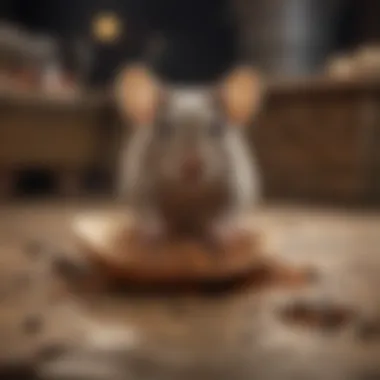Unlocking the Top Strategies for Effective Mouse Trap Bait Selection


Animal Species Profile
When it comes to pest control, understanding the animal species you are dealing with is crucial. Mice, often seen as unwelcome guests in homes and establishments, are small rodents known for their characteristic features. These nocturnal creatures typically have small bodies covered in fur, long tails, and prominent ears. Their adaptable nature allows them to thrive in various environments, making them a common presence worldwide.
Prevalent Mouse Species
Two of the most common mouse species encountered in urban areas are the House Mouse (Mus musculus) and the Deer Mouse (Peromyscus maniculatus). House Mice are usually gray or brown with a lighter underbelly and can reproduce rapidly, leading to infestations if not controlled. Deer Mice, on the other hand, have distinct white feet and underbellies, posing health risks due to their potential carrier status for Hantavirus.
Understanding Mouse Behavior
Mouse behavior is driven by their survival instincts and hierarchical social structure. They exhibit exploratory behavior, using scent trails and pheromones for communication. Mice also showcase territorial instincts, marking their territory with urine and feces. Understanding their behavior patterns is essential for effective pest control strategies, especially when selecting the most enticing bait for traps.
Understanding the Importance of Mouse Trap Bait
In the domain of pest control, the selection of the most effective bait for mouse traps plays a pivotal role. Choosing the right bait can significantly impact the success of mouse trapping endeavors. Understanding the importance of mouse trap bait involves delving into specific elements such as the bait's enticing properties, its ability to lure and capture mice effectively, and the considerations involved in selecting the appropriate bait for different scenarios. This section provides a foundational comprehension of why mouse trap bait holds such significance in enhancing pest control strategies.
Role of Bait in Mouse Trapping
Enhancing trap effectiveness
When it comes to enhancing trap effectiveness, the bait serves as a crucial element in attracting mice towards the trap. The choice of bait can determine how successful the trap is in capturing rodents. By selecting bait that is appealing to mice while also considering their sensory preferences, trap effectiveness can be maximized. The feature that sets enhancing trap effectiveness apart is its direct correlation to the overall efficacy of the trapping process. This choice of bait is popular for its ability to efficiently entice mice towards the trap, making it a strategic option for pest control initiatives.
Attraction of mice
The ability to attract mice is a fundamental aspect of successful mouse trapping. Understanding what entices mice to the trap is key to effectively capturing them. The bait plays a pivotal role in drawing mice towards the trap, ultimately facilitating their capture. Attraction of mice is beneficial because it capitalizes on rodents' natural instincts to seek out food sources, making it a reliable and popular choice for those aiming to control mouse populations.
Increasing trap success rate
Increasing the trap success rate is a primary goal when setting up mouse traps. By utilizing bait that is appealing and irresistible to mice, the chances of successfully capturing rodents are significantly heightened. This aspect stands out for its direct impact on the overall success of mouse trapping efforts. The unique feature of increasing trap success rate lies in its ability to elevate the efficiency of traps by ensuring a higher rate of rodent capture. This choice of bait is advantageous as it substantially improves the outcomes of trapping initiatives.
Factors Influencing Bait Selection


Mouse preferences
Understanding the preferences of mice is crucial in selecting the most suitable bait for trapping purposes. Different mice may have varying tastes, and discerning these preferences can aid in choosing bait that appeals to a wider range of rodents. This consideration is beneficial as it allows for the customization of bait choices based on specific mouse behaviors and tendencies. Despite potential disadvantages such as selectivity in preferences, catering to mouse tastes enhances the overall effectiveness of trapping methods.
Environmental considerations
Environmental factors can significantly influence bait selection for mouse traps. Considering aspects such as humidity, temperature, and surrounding habitat can impact the attractiveness and efficacy of the bait. Environmental considerations play a vital role in ensuring that the chosen bait remains appealing and effective in specific settings. This choice is advantageous for adapting bait options to varying environmental conditions, although it may present challenges in maintaining bait allure in fluctuating habitats.
Seasonal variations
Seasonal changes can impact the availability and suitability of bait for mouse traps. Adjusting bait choices according to seasonal variations is essential to account for fluctuations in rodent behavior and food preferences across different times of the year. Seasonal variations provide insights into the ideal bait options for particular times, ensuring optimal trapping outcomes. This approach proves beneficial for aligning bait selection with seasonal demands, although it may pose challenges in predicting mice behaviors during transitional periods.
Types of Mouse Trap Bait
In this comprehensive guide on finding the most effective mouse trap bait, understanding the different types of bait plays a pivotal role. Choosing the right bait can significantly enhance the success rate of trapping pesky mice. When considering the types of mouse trap bait, factors such as attractiveness to mice, availability, and cost come into play. Food-based baits, protein-based baits, and alternative bait options offer a range of choices to cater to varying mouse preferences and environmental considerations.
Food-Based Baits
When delving into food-based baits, options like cheese, peanut butter, chocolate, and grains emerge as popular choices for enticing mice. Each type of food bait carries its own unique characteristics that appeal to rodents differently. For example, cheese, a classic bait, may attract mice with its strong odor and saltiness. Peanut butter, on the other hand, offers a sticky and irresistible consistency that mice find hard to resist. Chocolate provides a sweet and aromatic lure, while grains present a versatile and budget-friendly option for mouse trapping purposes.
Cheese
Cheese stands out as a traditional and widely used bait for mouse traps. Its pungent smell and savory taste make it a favorite among rodents. However, while cheese is effective in attracting mice due to its strong odor, it can sometimes dry out quickly, reducing its long-term efficacy as bait. Therefore, regular replacement and monitoring of cheese bait are necessary to maintain its allure and effectiveness.
Peanut Butter
Peanut butter reigns supreme as a go-to bait for mouse traps, thanks to its sticky texture and high-fat content that appeals to mice's taste buds. Its versatility in adhering to traps and its long-lasting aroma make it a reliable choice for trapping rodents. Despite its effectiveness, peanut butter can be prone to spoilage over time, requiring periodic checks and refreshment to uphold its attractiveness to mice.
Chocolate
While unconventional, chocolate serves as a compelling bait option due to its sweetness and strong scent. Mice are naturally drawn to sugary foods, making chocolate a tempting lure for trapping them. However, chocolate's melting properties under varying temperatures can pose challenges in maintaining its efficacy as bait. Regular monitoring and adjustment of chocolate bait become essential to ensure consistent trapping success.
Grains


Grains, such as oats or cereals, provide a cost-effective and sustainable bait solution for mouse traps. Their neutral scent and widespread availability make them a practical choice for attracting mice without overwhelming them with strong odors. Grains also offer the flexibility of pairing with other baits to create customized bait blends based on mouse preferences and environmental factors. While grains may not have the immediate impact of stronger-smelling baits, their subtle allure can yield positive results when used strategically and in conjunction with other bait types.
Factors to Consider When Choosing Mouse Trap Bait
In this article on finding the most effective mouse trap bait, understanding the factors to consider plays a crucial role. When contemplating mouse trap bait selection, several elements warrant attention for optimal results in pest control. By delving into mouse preferences, environmental conditions, and seasonal variations, one can tailor their bait choice to attract rodents successfully. Considering these factors not only enhances trap effectiveness but also increases the overall success rate of trapping efforts.
Scent Attractiveness
Strong odor vs. subtle scent
When debating between a strong odor and a subtle scent for mouse trap bait, the choice significantly impacts trapping outcomes. Opting for a strong odor can be advantageous as it tends to attract mice more effectively due to their keen sense of smell. However, a subtle scent may have its merits, especially in environments sensitive to overpowering odors. Careful consideration of the environment and mouse behavior is crucial to determine the most suitable scent intensity to enhance bait attractiveness.
Mice preferences for specific smells
Understanding mice's preferences for specific smells is pivotal in selecting the most enticing bait. Different mouse species exhibit varying scent preferences, making it essential to cater to their olfactory inclinations. By incorporating fragrances that mice find alluring, such as certain foods or herbal scents, one can optimize the bait's attractiveness. However, it is imperative to strike a balance between preferred smells and practical considerations to ensure successful trapping outcomes.
Nutritional Value
Balanced nutrition vs. high-calorie treats
The nutritional value of mouse trap bait, whether balanced or high in calories, influences its efficacy in luring rodents. While high-calorie treats may seem enticing, providing a quick energy boost for mice, a well-balanced nutritional option could yield better long-term trapping success. Incorporating a mix of nutrients that align with mice's dietary needs can lead to sustained interest in the bait, increasing the likelihood of trapping success.
Healthier options for bait
Exploring healthier bait options can be a strategic approach in mouse control efforts. By offering baits with healthier ingredients, such as wholesome grains or organic proteins, one not only attracts mice but also promotes their well-being. Healthier bait choices not only align with ethical pest control practices but also ensure a more sustainable approach to managing rodent infestations.
Availability and Cost
Economical bait options
Considering economical bait options is key for individuals seeking cost-effective pest control solutions. Opting for bait materials that are readily available and affordable can streamline trapping processes without compromising effectiveness. By leveraging economically viable bait options, individuals can sustain their pest control efforts without incurring substantial costs, making it a practical choice for long-term rodent management.
Common household items as bait


Utilizing common household items as bait presents a convenient and accessible approach to mouse trapping. Everyday items like chocolate, birdseed, or even dry pet food can serve as effective bait options, eliminating the need for specialized products. This approach not only enhances the feasibility of mouse trapping but also presents a sustainable and budget-friendly alternative for individuals aiming to address rodent issues within their homes.
Tips for Maximizing Mouse Trap Bait Effectiveness
In this section, we dive into crucial strategies to enhance the efficiency of your mouse trapping endeavors. Understanding how to optimize your bait usage can significantly increase your success rate in capturing mice. By implementing these tips, you can improve the effectiveness of your traps and minimize the chances of mice evading your efforts. The proper utilization of bait can make a substantial difference in the outcomes of your pest control methods.
Placement Strategies
Near Mouse Pathways:
When it comes to placing bait near mouse pathways, you're strategically targeting areas where mice frequently traverse. By positioning bait along these pathways, you increase the likelihood of mice encountering and being attracted to the bait. This method capitalizes on mice's natural instincts to explore familiar routes, making it an effective way to entice them towards the traps. Utilizing near mouse pathways as a bait placement strategy is a popular choice due to its practicality and proven success in capturing mice.
Secured on Traps:
Securing bait directly onto traps ensures that mice must interact with the trap mechanism to access the bait. This method not only increases the chances of trapping a mouse but also prevents them from stealing the bait without being caught. Placing bait in a manner that requires mice to engage with the traps reinforces the efficacy of the trapping process and improves the overall success rate of capturing mice.
Multiple Bait Stations:
Utilizing multiple bait stations scattered across different areas can increase the coverage of your trapping efforts. By setting up multiple stations, you create more opportunities for mice to encounter the bait, leading to higher chances of successful captures. This approach diversifies your trapping strategy, making it harder for mice to avoid the traps. However, managing multiple bait stations effectively is key to ensuring their success, as each station should be strategically positioned to maximize capture rates.
Refreshment Frequency
Regular Bait Replacement:
Regularly replacing bait is essential to maintaining its attractiveness and effectiveness. As mice consume bait or when it becomes stale, its potency decreases, reducing the chances of luring mice into traps. By consistently refreshing bait, you ensure that it remains enticing to mice, increasing the likelihood of successful captures. Monitoring and replacing bait at appropriate intervals is crucial for sustaining the efficiency of your trapping efforts.
Monitoring Bait Condition:
Keeping track of the condition of your bait is vital in determining its appeal to mice. Monitoring bait quality helps you assess its effectiveness and make informed decisions regarding when to replace it. By observing the condition of the bait, such as changes in texture or odor, you can proactively adjust your baiting strategy to maximize its allure to mice. Regularly checking and monitoring bait condition is a proactive measure that enhances the overall success of your trapping endeavors.
Experimentation with Bait Types
Rotating Bait Options:
Rotating between different bait types prevents mice from becoming resistant to a specific type of bait. By introducing variety, you keep mice intrigued and increase the chances of them interacting with the traps. Rotating bait options also allows you to identify which bait types are most effective in attracting mice, enabling you to fine-tune your trapping strategy for optimal results. Experimenting with various baits provides insights into mice's preferences and behaviors, guiding you towards selecting the most enticing options.
Observing Mouse Responses:
Observing how mice interact with different bait types provides valuable insights into their preferences and behaviors. By paying attention to which baits attract mice more effectively, you can adjust your baiting strategy accordingly. Understanding how mice respond to different stimuli informs your decision-making process, helping you tailor your trapping approach to align with mice's behaviors. Observing mouse responses allows you to optimize your bait selection and placement, increasing the overall success rate of your trapping efforts.







